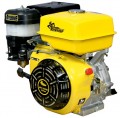Max. torque
The maximum torque developed by the engine during operation. Note that such an indicator is usually achieved only at certain speeds — this nuance can be specified in the characteristics.
Torque can be simplistically described as the force exerted by a motor on a shaft. The higher this effort, the more “high-torque” the motor is, the better it overcomes resistance and handles with high loads. The torque value is directly related to the power. For example, for 5 hp models. and less torque
up to 10 Nm is considered quite normal, engines of 4 – 7 hp. give out
from 10 to 20 Nm, and values
of 20 Nm or more are found in units with a power of at least 8 hp. At the same time, engines of the same power may differ in actual force. So this indicator characterizes the capabilities of the unit well in comparison with analogues.
It is worth saying that many consider torque to be a more reliable and visual parameter than power: the latter can be indicated in different ways (nominal, maximum, etc.), while torque is a completely unambiguous characteristic.
Shaft type
Shaft type, more precisely, the type of fastening for the hub provided on the shaft shank.
Recall that a hub is a part with a hole that is put on the shaft; it is through this part that the rotation is transmitted to the mechanism with which the engine is used. The general rule in this case is this: the type of shaft must match the type of mounting on the hub, otherwise normal operation will not be possible. Nowadays, there are units with shafts
under the key,
under the spline,
under the cone and
under the thread. Here is a more detailed description of each option:
— Dowel. Connection using a key — an elongated part placed in a special longitudinal groove. More precisely, there are two grooves: one is located on the shaft, the other is on the hub, and the key is tightly installed in the space formed by the grooves and connects the shaft and the hub. Such connections are simple and at the same time quite functional, due to which they are widespread and found in engines of all price and “weight” categories. On the other hand, a keyed connection is less secure than a splined connection and is less suitable for high RPM and/or heavy loads.
— Slots. Connection based on slots — longitudinal slots. Most often, there are six of them on the shaft, and the seat on the hub has the appropriate shape — in the form of a charac
...teristic asterisk. A spline connection is more complicated and more expensive than a keyed connection, and numerous slots reduces the strength of the shaft and it has to be made thicker. However, the connection itself is very reliable, as it evenly distributes the load during rotation. Therefore, splines are recommended for work at high loads.
— Cone. A shaft with a shank in the form of a cone (tapering towards the end), in the centre of which there is a hole with an internal thread. It is used quite rarely, mainly on fairly powerful units — from 7 hp. and higher.
— Carving. Cylindrical shank with external thread. A rather specific option that has not received much distribution — in particular, due to the fact that the thread tends to loosen from vibrations as it is used, and significant efforts may be required to connect and disconnect the shank and hub.Shaft length
It is customary to call the shaft length only the length of its outer part protruding beyond the engine housing. The optimal value of this parameter depends on the characteristics of the machine in which the engine is planned to be installed.
Piston diameter
The engine piston diameter is a reference parameter — in fact, this data is required very rarely, usually, for repairs and other specific tasks that the average user usually does not deal with at all.
Piston stroke
The distance that an engine piston travels from one extreme point to another. In general, it is a rather specific characteristic and is rarely required in fact (for most ordinary users, it is never needed at all in the entire “life” of the engine).
Specific fuel consumption
Specific consumption in this case can be described as the amount of fuel consumed by the engine per hour per 1 kW of generated power. The lower this figure, the higher the efficiency of the engine and the more economical it is. Specific consumption data is especially useful for comparing units with different capacities.

